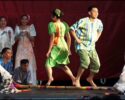Singkil is a very unique Philippines traditional dance of the Maranao people in Southern Philippines. It is said to be inspired by the age-old Hindu epic “Ramayana” and other mythological epic from South East Asia called “Darangen“. This “folk” dance is said to have originated from the Lake Lanao region in the island of Mindanao in Southern Philippines. It was first popularised by the Bayanihan Philippine National Folk Dance Company. Apparently this dance is mainly performed during festive occasions. Furthermore, it also possesses a few adaptations which include a dance referred to as Rajah Bantugan. In addition, this dance style was first used in the 2001 American independent film known as “The Debut” which was directed by a Filipino American named Gene Cajayon.
Singkil, the Filipino dance, involves rich ornamental costumes and a female lead and male lead and other dancers elegantly dancing between rhythmically striking bamboo poles held by the fellow dance troupe. There are many bamboo pole based dances in the world but this one has a distinctive flair about it.
History and origin of the Singkil Dance:
According to the cultural history of the Philippines, this form of dancing is said to have been developed and created by people living in the Lake Lanao area. Apparently, this dance form was created from a story written in the “
Costumes used in the Singkil Dance:
A Maranaw costume is mainly worn in this form of dancing. In addition, the female lead dancer wears an elaborate dress of a princess and holds “decorated fans” in both hands, while the male lead dancer holds either handkerchiefs in both hands and in some cases a sword and a shield.
Music involved in the Singkil Dance:
The musical instruments used in this dance form are the kotiyapi i.e. bamboo guitar, insi i.e. bamboo flute, kobing i.e. harp, and tintikan i.e. metal sticks. These instruments cannot be divided or combined with other ensembles because they are tuned to each other and are forged in either brass or bronze.
According to the cultural history of the Philippines, this dance style was created to honour the “Holy Cross of Alitagtag” also known locally as the “Mahal Na Poong Santa Cruz”, and is performed mainly in the month of May.
Singkil Dance Moves:
The four movements of the contemporary version of this dance are as follows:
- The maidservant carrying an umbrella who typically comes before the performance of Singkil is introduced in the first movement, asik. In the Maranao language, asik means “agitated, or to leap for joy or anger.” The umbrella-carrying attendant performs a solo dance to appease her sultan master (some scholars refer to her as a “slave”)
- The entrance of the princess, resplendent in glowing golds, sapphires, and other jewel tones, is heralded by the chimes and gongs in the second movement. In a solemn procession, the princess is carried by her manservants in a sedan chair or a litter, depending on the dance company’s resources and capabilities. The tiny bells on her ankles serve as a mark for tracking her movements. Typically, her entourage of ladies-in-waiting precedes her, flourishing their measured movements while maintaining dignified expressions on their faces, and carrying either scarfs, fans, or decorative umbrellas. The prince then appears, courting the princess as she dances across from him while brandishing a kris (a Malay-Indonesian dagger with a wavy-edged blade) and a shield.
- The third movement has a slow section called patay, which translates to “dead.” It is a common dance structural convention in Western performances.
- The fourth movement, which is the climax, features all of the dancers moving to the music’s crescendo as the speed of the bamboo poles they are deftly navigating between quickens the tempo. Therefore, performers would deftly enter and exit clapping bamboo poles, while the principal lady attendant would faithfully follow her mistress everywhere she went. The princess and the prince leave after the dance and return home.
Training availability and the technique involved in the Singkil Dance:
In terms of technique, this dance involves the lead dancer (i.e. female) locally known as “Putri Gandingan” (the name of Sita as mentioned in the Darangen) gracefully stepping in and out of closing bamboo poles that are arranged on the floor in either a parallel, rectangular, and criss-cross manner.
The Maranao prince and princess originally performed Singkil as a ritual for festivals and ceremonial rites of passage to establish their courtship. But because it is frowned upon for Muslim men and women to dance together, especially for royalty, only women, especially those of noble blood, began to perform the Singkl. It is intended to demonstrate her suitability for marriage in an overt or covert advertisement to prospective suitors while showcasing the dexterity of the young girl evolving into a woman with each step. Later adaptations increased the number of sets to add more thrill and excitement. Another distinguishing difference from the original is the addition of male dancers who serve as pole clappers.
In addition, the performer also uses either apir i.e. fans or mosala i.e. scarves while dancing. As for training availability, there are none available around the world since this “folk” dance is mainly performed in the Lake Lanao region in the Philippines.


